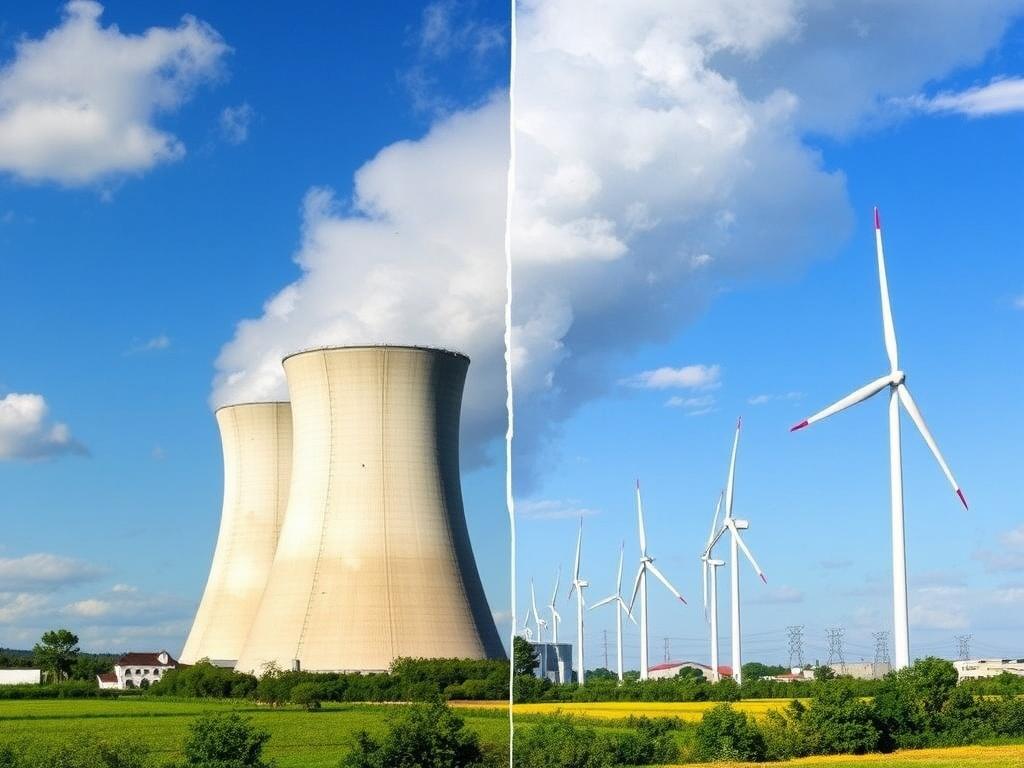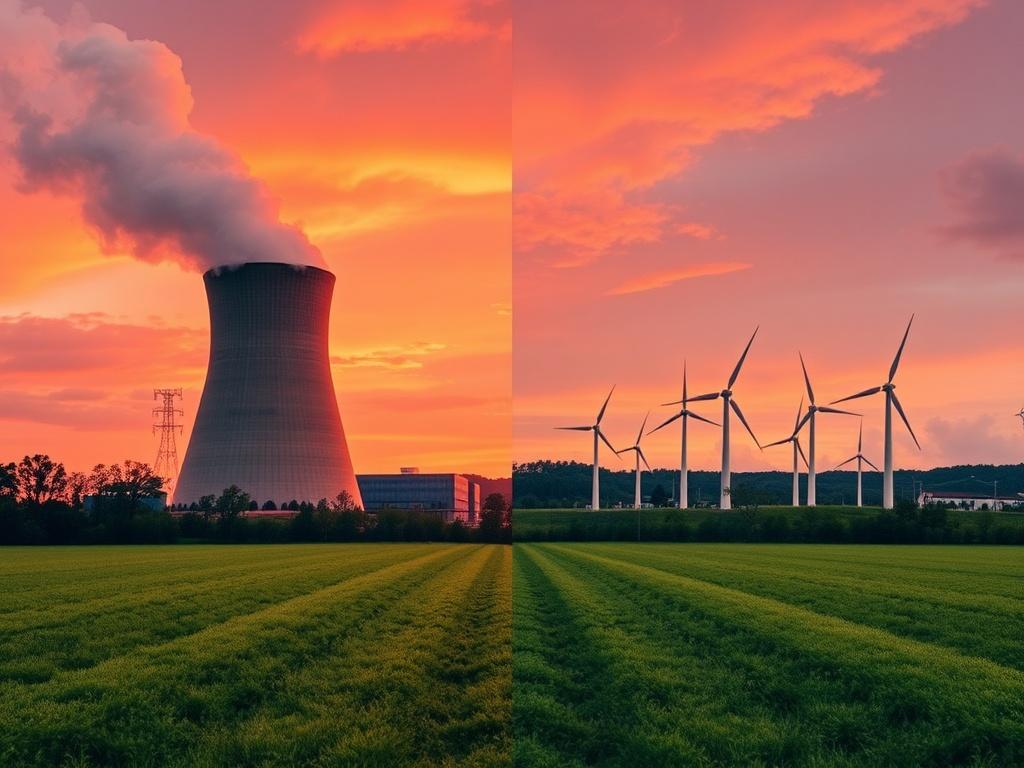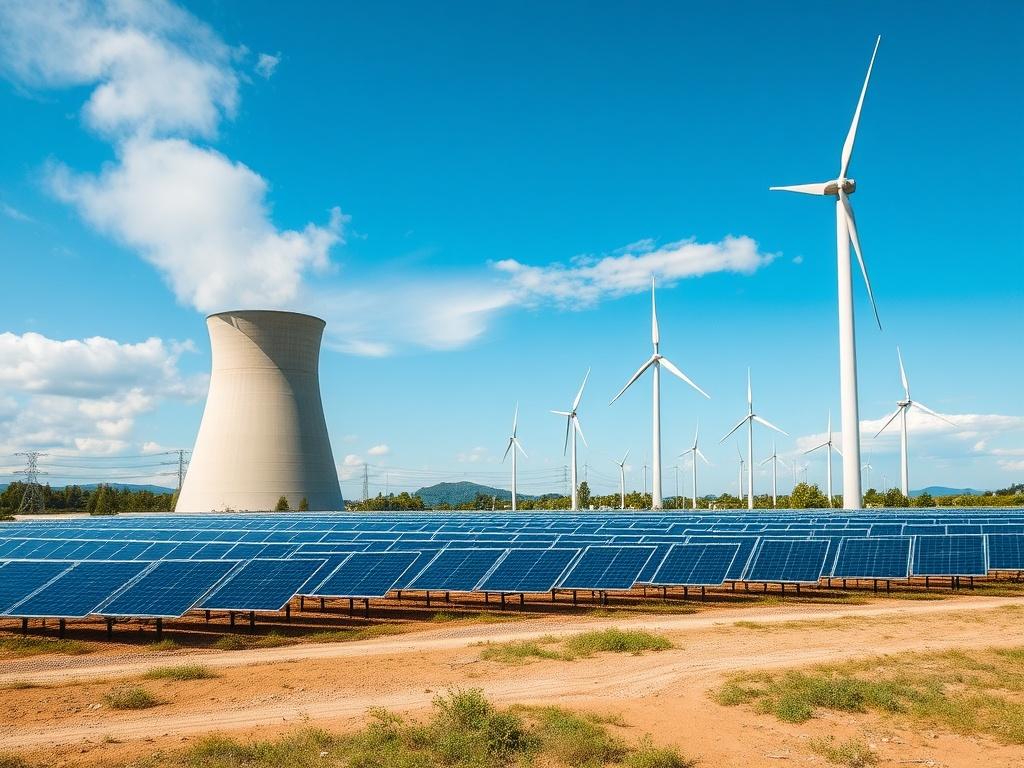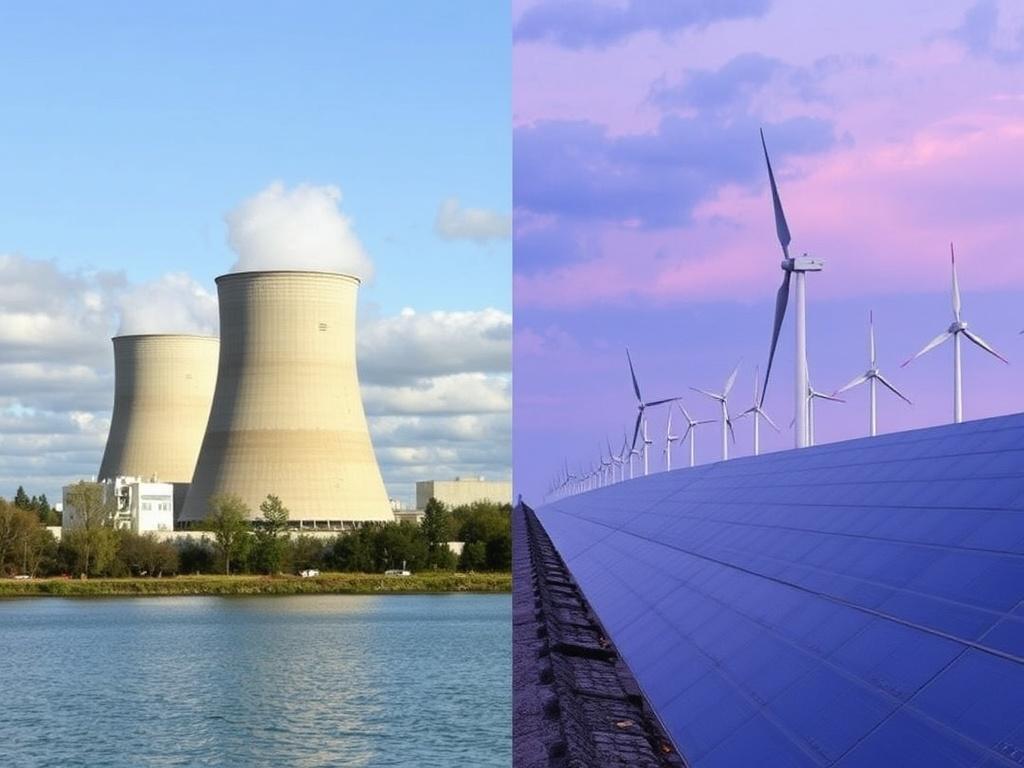- Why this debate matters now
- The basics: What we mean by nuclear and renewables
- Nuclear energy
- Renewable energy
- Pros and cons: A direct comparison
- Advantages of renewables
- Drawbacks of renewables
- Advantages of nuclear
- Drawbacks of nuclear
- Cost, economics, and financing
- Levelized cost of energy and system costs
- Financing and risk
- Safety, waste, and public perception
- Nuclear safety record and technological improvements
- Radioactive waste
- Public perception and social license
- Grid reliability, intermittency, and the role of storage
- Intermittency and flexibility
- Nuclear as a reliability anchor
- Energy storage: the equalizer
- Technological innovations changing the conversation
- Small modular reactors (SMRs)
- Advanced renewables and storage
- Policy choices and investment strategies
- Policy levers
- Local vs. centralized approaches
- Lessons from real-world examples
- France: nuclear-heavy, low-carbon grid
- Germany: renewables and nuclear phase-out
- United States: regional diversity and technology experimentation
- How a mixed strategy might look in practice
- Principles for a mixed energy system
- Role of industry and innovation
- Common objections and thoughtful responses
- What consumers and communities should consider
- Questions to ask developers and policymakers
- Paths forward: scenarios and timelines
- Near term (next 5–10 years)
- Medium term (10–20 years)
- Long term (20+ years)
- Table: Quick comparison of attributes
- Practical policy recommendations
- Short list of actions
- Conclusion
The debate about how to power our future tends to turn into a passionate argument, with nuclear energy and renewable energy often cast as opposing champions. But what if the real choice isn’t one or the other? What if the question we should be asking is how to combine nuclear and renewables to build a resilient, low-carbon energy system that works for people, economies, and the planet? In this article we’ll take a practical, conversational look at the strengths and weaknesses of each option, how they complement one another, and what a sensible energy mix might look like as we race to cut carbon emissions and keep lights on.
I’ll walk you through the basics, then dig into economics, safety, grid reliability, technologies like small modular reactors and battery storage, and the policy choices that will shape whether societies adopt a mixed approach or double down on a single path. Along the way we’ll look at data, real-world examples, and common objections. By the end you should have a clear idea of why many experts now say that we don’t need to choose — we need both.
Why this debate matters now

The climate clock is ticking. To avoid the worst consequences of climate change, scientists urge drastic reductions in greenhouse gas emissions over the next few decades. Electricity is a major source of emissions, and it’s also an area where rapid change is possible. The choices we make about how to produce electricity will ripple through our economies and daily lives.
Renewable energy sources like solar and wind have seen dramatic cost declines and rapid deployment. They are clean at the point of generation, modular, and public-friendly. Nuclear power, long a controversial option, offers massive amounts of carbon-free power with a small land footprint and excellent operational reliability. Because both provide carbon-free electricity, both are central to many models that get us to net-zero emissions.
Yet each comes with trade-offs. Renewables are intermittent and need storage or backup. Nuclear has upfront costs, long project timelines, and public concerns about accidents and waste. The key question for policy-makers, investors, and communities is whether we can build an energy system that leverages the advantages of each while managing their downsides.
The basics: What we mean by nuclear and renewables
Let’s unpack the main technologies in play so we have the same vocabulary.
Nuclear energy
Nuclear power plants produce heat through nuclear fission, typically splitting uranium atoms to release energy. That heat turns water into steam, which drives turbines to make electricity. Modern nuclear reactors operate around the clock and offer consistent, high-capacity output — often referred to as baseload power. New designs aim to improve safety and reduce costs, and small modular reactors (SMRs) promise shorter construction times and greater flexibility.
Nuclear energy keywords in common conversations: nuclear power, nuclear reactors, uranium fuel, small modular reactors (SMRs), radioactive waste, reactor safety, baseload power.
Renewable energy
Renewable energy covers a variety of sources that replenish naturally: solar photovoltaic (PV), wind turbines (onshore and offshore), hydropower, geothermal, and biomass. Solar and wind have seen the fastest growth because of steep cost declines and ease of deployment. The main challenge for these technologies is intermittency: the sun doesn’t shine at night and the wind doesn’t blow on command. That means integration with energy storage, demand management, and grid upgrades is vital.
Renewable energy keywords in common conversations: renewable energy, solar power, wind power, hydropower, energy storage, battery storage, grid integration, intermittency.
Pros and cons: A direct comparison

To make thoughtful choices we need to balance benefits and drawbacks. Here’s a compact comparison that helps frame the rest of the discussion.
Advantages of renewables
Renewables bring several clear strengths:
- Low operational emissions: Solar and wind produce electricity without on-site CO2 emissions.
- Rapid deployment: Projects can be built quickly, from distributed rooftop solar to utility-scale wind farms.
- Falling costs: Technology and manufacturing improvements have driven down prices for solar panels and wind turbines.
- Scalability and modularity: Systems can be scaled in small increments, useful for rural electrification and distributed energy.
- Public acceptability: Generally high public support for visible, non-radioactive clean energy.
Drawbacks of renewables
But renewables face real challenges:
- Intermittency and variability: They produce variable power, making grid integration more complex.
- Land and resource use: Large deployments require land, and some sites can conflict with other uses or ecosystems.
- Storage needs: To be fully reliable, renewables often need batteries, pumped hydro, or other storage solutions.
Advantages of nuclear
Nuclear power offers a distinct set of benefits:
- High energy density: A small amount of fuel yields a large amount of power, and nuclear plants have a small land footprint compared to large renewables installations.
- Reliable, continuous generation: Nuclear provides stable baseload electricity irrespective of weather.
- Low operational CO2 emissions: Like renewables, nuclear generates electricity with minimal direct greenhouse gas emissions.
- Long operational life: Reactor plants often operate for decades with high capacity factors.
Drawbacks of nuclear
Nuclear also has notable concerns:
- High upfront costs and long lead times: Building large reactors can take a decade or more and cost billions.
- Waste management: Radioactive waste requires secure handling and long-term planning.
- Public apprehension and political risk: High-profile accidents have left a legacy of fear and stringent regulation.
- Proliferation concerns: Nuclear technology requires governance to prevent misuse.
Cost, economics, and financing
One of the most practical debates revolves around money. Which option gives the best value, fastest deployment, and most reliable return?
Levelized cost of energy and system costs
The levelized cost of energy (LCOE) is a common metric for comparing technologies: it spreads total lifetime costs (construction, operation, fuel, financing, decommissioning) across the electricity produced. In recent years, solar and onshore wind have achieved very low LCOEs in many regions, driven by manufacturing scale and efficiency gains. That’s a major reason for their rapid adoption.
However, LCOE can be misleading when comparing intermittent renewables with dispatchable sources like nuclear. Renewables may have low LCOE but require system-level investments — storage, transmission upgrades, and flexible backup generation — to provide the same level of reliability. When those integration costs are included, the effective cost increases.
Nuclear’s LCOE tends to be higher, primarily because of capital costs and financing. But nuclear’s ability to deliver continuous power means it can displace investments in flexible backup capacity and long-duration storage. In certain contexts — dense urban grids, islands, or industrial clusters — that value can make nuclear more competitive.
Financing and risk
Financiers dislike uncertainty. The long construction times for traditional reactors expose projects to cost overruns and regulatory changes. That drives up the cost of capital and makes investors wary. In contrast, modular, fast-to-deploy renewable plants often offer quicker returns and less regulatory risk. SMRs are being developed in part to address financing risk via factory production, predictable schedules, and smaller capital outlays.
Policy mechanisms also shape outcomes: carbon pricing, clean energy subsidies, long-term power purchase agreements (PPAs), and state-backed financing all tilt the playing field. Countries that want nuclear as part of their decarbonization strategy often provide public financing or guarantees to bridge the gap.
Safety, waste, and public perception
Safety and waste are the most emotionally charged parts of the nuclear-renewables debate. Understanding the facts helps separate fear from technical realities.
Nuclear safety record and technological improvements
Serious accidents at Chernobyl and Fukushima have left lasting scars. They underscore the importance of robust design, regulation, and emergency preparedness. But it’s also true that modern reactor designs incorporate passive safety systems, redundant controls, and better materials. Newer generations of reactors and SMRs are engineered to shut down safely without human intervention or external power.
Statistically, when measured in deaths per unit of electricity generated, nuclear has a favorable safety record compared to fossil fuels and is comparable to large hydropower when accounting for rare but severe dam failures. That doesn’t erase public concerns, but it provides context.
Radioactive waste
Radioactive waste management is a solvable engineering problem, though politically challenging. High-level waste is typically small in volume and can be contained, stored, or reprocessed. Some countries, like Finland and Sweden, are advancing deep geological repositories for long-term disposal, showing that responsible solutions are possible with long-term political commitment.
Recycling and advanced fuel cycles can reduce waste volume and toxicity, but they introduce proliferation and technical complexities. Decisions about waste management require transparent governance, robust science, and community participation.
Public perception and social license
Public acceptance is pivotal. Renewables generally enjoy strong public support, especially rooftop solar. Nuclear acceptance varies widely by country and community, shaped by history, trust in institutions, and perceived risk. Successful deployment of either technology depends on local engagement, fair siting processes, and benefits for affected communities.
Grid reliability, intermittency, and the role of storage

One of the biggest technical puzzles is maintaining a reliable grid with high shares of variable renewables. How do we make sure the lights stay on?
Intermittency and flexibility
Solar and wind are variable, but not an insurmountable problem. Grids can handle high penetrations of renewables with a combination of approaches:
- Geographic diversity: Spreading generation across regions smooths variability.
- Demand response: Adjusting demand to match supply — for example, incentivizing flexible industrial loads or electric vehicle charging at off-peak times.
- Energy storage: Batteries for short-duration smoothing, pumped hydro for longer periods, and emerging long-duration storage options like compressed air or chemical fuels.
- Flexible generation: Gas or other dispatchable units that can ramp up when needed, ideally low-carbon options like hydrogen-ready turbines or biomass.
Nuclear as a reliability anchor
Nuclear’s greatest grid advantage is reliability. A fleet of reactors can provide predictable baseload and grid inertia that helps stabilize frequency. This can reduce the need for certain types of storage or backup capacity. However, nuclear’s inflexibility (traditional reactors do not ramp easily) can be a downside when the grid needs rapid load-following to match surges in solar or wind. Some advanced reactors and SMRs are designed for more flexible operation, potentially offering both baseload and grid-balancing services.
Energy storage: the equalizer
Storage technologies are crucial to any high-renewables system. Short-duration lithium-ion batteries have become cost-effective for hours-long services like frequency regulation and peak shaving. For days or weeks of storage, we need alternative solutions: pumped hydro, thermal storage, hydrogen production and storage, or novel chemistries. The economics of long-duration storage are still evolving, and where storage costs fall matters to the overall choice between heavy reliance on renewables plus storage and a system that keeps nuclear plants on as a reliability backbone.
Technological innovations changing the conversation
The energy landscape is not static. New technologies are shifting the trade-offs and opening possibilities for mixed solutions.
Small modular reactors (SMRs)
SMRs are a class of nuclear reactors designed to be smaller, prefabricated, and built in factories. They promise:
- Lower upfront capital per unit and shorter on-site construction times.
- Scalability: multiple modules can be added as demand grows.
- Enhanced safety features and passive cooling designs.
- Potential for non-electrical uses, such as process heat for industry or hydrogen production.
If SMRs can deliver on cost, public safety, and timely deployment, they could make nuclear more accessible and compatible with variable renewables.
Advanced renewables and storage
Solar cell efficiency continues to improve, wind turbines are growing taller and more effective, and floating offshore wind opens new regions for deployment. On the storage front, flow batteries, advanced compressed air, liquid air energy storage, and chemical carriers like green hydrogen and ammonia are being piloted for longer-duration storage needs. These technologies will directly influence whether a grid can rely primarily on renewables or needs a nuclear component.
Policy choices and investment strategies
How governments and investors decide matters. Policy frameworks can either enable a balanced energy mix or push systems towards extremes.
Policy levers
Key tools include:
- Carbon pricing or emissions trading systems that internalize the cost of fossil fuels.
- Clean energy standards that mandate or incentivize minimum shares of zero-carbon generation.
- Long-term contracts and guaranteed off-take (like power purchase agreements) to reduce revenue risk for heavy capital investments.
- R&D funding and demonstration projects for emerging technologies like SMRs and long-duration storage.
- Grid planning and modernized market rules that value flexibility, capacity, and clean attributes appropriately.
Countries that have successfully integrated high shares of clean energy have combined market reforms, targeted subsidies, and clear planning.
Local vs. centralized approaches
A decentralised system emphasizing rooftop solar, local batteries, and microgrids offers resilience and community benefits. A centralized approach with large nuclear plants provides predictable bulk power and can anchor industrial clusters. The optimal mix often depends on geography, existing infrastructure, economic structure, and political priorities. Hybrid models — regional grids with both utility-scale renewables and a mix of large and small nuclear plants — are increasingly attractive.
Lessons from real-world examples
Looking at countries that have taken different paths helps illuminate practical outcomes.
France: nuclear-heavy, low-carbon grid
France historically built a large nuclear fleet that now provides a high share of the country’s electricity with very low emissions. The country benefited from centralized planning and standardized reactor designs, which kept costs and timelines more manageable. However, aging reactors and the need for maintenance have created new challenges and political debates about future energy mixes that include more renewables.
Germany: renewables and nuclear phase-out
Germany pursued an aggressive renewable expansion while phasing out nuclear after Fukushima. This transition highlights both successes and challenges: massive investments in wind and solar brought down costs and built domestic industry, but intermittency required increased reliance on gas and imports at times. The German case demonstrates that renewables can scale rapidly, but system-level integration remains vital.
United States: regional diversity and technology experimentation
The U.S. showcases regional diversity: some states lean heavily on renewables, others maintain nuclear fleets, and several pilot SMR projects and long-duration storage demonstrations are underway. Market-based electricity systems, differing state policies, and federal R&D support create a patchwork of approaches and lessons.
How a mixed strategy might look in practice
If the goal is cost-effective, reliable, low-carbon electricity, what might a combined approach entail?
Principles for a mixed energy system
A balanced strategy would:
- Deploy solar and wind rapidly where they are cheapest, maximizing near-term emissions reductions.
- Invest in grid upgrades, interconnections, and storage to integrate high shares of renewables.
- Use nuclear — including SMRs — to provide reliable baseload and firm capacity in regions where it’s economically and politically viable.
- Prioritize flexible operation, demand response, and diversified storage portfolios to reduce reliance on any single technology.
- Align policy and financing to reward clean capacity, not just low short-term LCOE.
Role of industry and innovation
Industry must help by maturing cost-effective SMRs, driving down battery and long-duration storage costs, and developing hybrid solutions (e.g., co-located wind or solar with storage and flexible nuclear capacity). Cross-sector coupling — using electricity to produce low-carbon fuels and heat for industry — can also increase demand that supports large, firm clean capacity.
Common objections and thoughtful responses
The debate circles around a few recurring objections. Let’s address them.
<h3“We can get to 100% renewables”
Many studies suggest a technically feasible path to very high shares of renewables with sufficient storage, demand flexibility, and transmission. But feasibility is not the only metric — cost, speed, social acceptability, and reliability matter too. For some regions, relying solely on renewables could be more expensive or slower than a mixed approach. The pragmatic path often uses the fastest-deploying and most reliable options together.
<h3“Nuclear is too slow and costly”
Large reactors have struggled with cost and schedule overruns, and that’s a real concern. However, SMRs and streamlined regulatory pathways could reduce those risks. Political commitment and financing innovations are also necessary. Dismissing nuclear entirely on past performance risks overlooking technological improvements and contexts where nuclear might be the most sensible option.
<h3“Nuclear waste is unsolvable”
Managing high-level waste requires long-term planning and secure facilities. Countries like Finland have shown that deep geological disposal is feasible technically. The challenge tends to be political and governance-related more than technical. Transparent processes and community benefits can make waste solutions acceptable.
What consumers and communities should consider
If you live in a community being asked to host energy projects, what should matter to you?
Questions to ask developers and policymakers
- What are the projected costs over time, including system integration costs?
- How will local jobs and economic benefits be shared with the community?
- What are the safety and environmental protection measures? Who oversees them?
- How will long-term liabilities (waste, decommissioning) be managed and funded?
- Are there opportunities for local ownership or community energy projects?
Communities should look for transparent engagement, rigorous environmental assessments, and clear commitments on benefits and protections.
Paths forward: scenarios and timelines
What does a plausible near-term timeline look like if we aim to cut emissions rapidly?
Near term (next 5–10 years)
Rapid deployment of wind and solar will continue, driven by falling costs and immediate emissions benefits. Short-duration battery storage will expand, and some regions will start pilot projects for long-duration storage. A handful of SMR demonstration projects could move from design to construction, and existing nuclear plants will either be refurbished or retired depending on maintenance costs and policy.
Medium term (10–20 years)
As long-duration storage technology matures and grid upgrades continue, higher shares of renewables become practical. SMRs may begin to offer competitive dispatchable power in select markets, while advanced reactors and fuel cycles might reach commercial readiness. Cross-sector electrification (transportation, heating, industry) will increase electricity demand and change the economics of baseload versus flexible power.
Long term (20+ years)
By mid-century scenarios, a diversified mix of renewables, firm low-carbon generation (potentially including nuclear), and robust storage and demand flexibility could deliver deeply decarbonized power systems. The exact balance will vary by region — island grids might favor nuclear plus renewables, whereas continental grids with interconnections could rely more heavily on renewables and storage.
Table: Quick comparison of attributes
| Attribute | Renewables (solar, wind) | Nuclear |
|---|---|---|
| Primary strength | Low operational cost, rapidly deployable, modular | Reliable, continuous high-capacity output |
| Main challenge | Intermittency, requires storage and grid upgrades | High upfront cost, long lead times, waste management |
| Land footprint | Large for utility-scale installations | Small relative to equivalent output |
| Carbon emissions (operational) | Near-zero | Near-zero |
| Construction time | Months to a few years | Years to a decade+ (SMRs aim to shorten this) |
| Public perception | Generally favorable | Varies widely; often contentious |
Practical policy recommendations
If you were advising a government or energy planner, what concrete steps would you recommend?
Short list of actions
- Adopt technology-neutral clean energy targets that value both low-carbon generation and firm capacity.
- Fund demonstration projects for SMRs and long-duration storage to reduce technological and financing risk.
- Invest in grid interconnection and modern market mechanisms that reward flexibility and capacity.
- Provide transparent, long-term funding arrangements for waste management and decommissioning in nuclear projects.
- Support distributed renewables for resilience and community ownership while ensuring coordinated system planning.
- Implement carbon pricing to align incentives across sectors and technologies.
These combined steps help ensure decisions are pragmatic, evidence-based, and oriented toward durable outcomes.
Conclusion
The question «Do we need both nuclear and renewables?» is less about ideology and more about pragmatism. Both nuclear energy and renewable energy have clear, complementary roles to play in a rapid and equitable transition to a low-carbon electricity system. Renewables, especially solar and wind, offer rapid emissions reductions at falling costs and are indispensable for near-term gains. Nuclear provides reliable, high-capacity, low-carbon power that can stabilize grids and supply energy for industrial needs, especially where storage and transmission face limits. The best strategy for many regions is a balanced, flexible approach that deploys renewables aggressively, invests in storage and grid modernization, and uses nuclear — including emerging SMRs where appropriate — as a firming resource. Policy and finance must evolve to value reliability, emissions reductions, and social acceptance equally, and communities must be part of the decision-making. In short, choosing between nuclear and renewables is less helpful than figuring out how to harness their strengths together to keep the lights on, the economy humming, and the planet livable.
Как вам статья?







